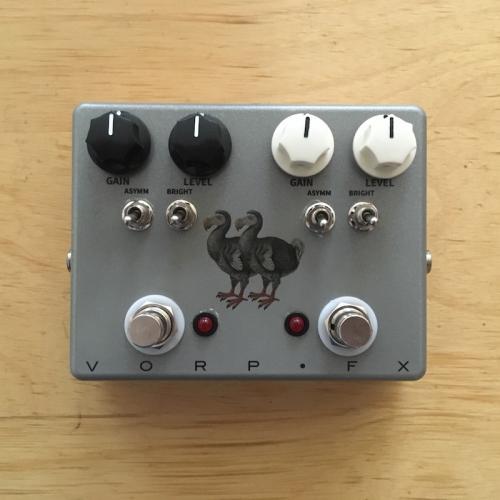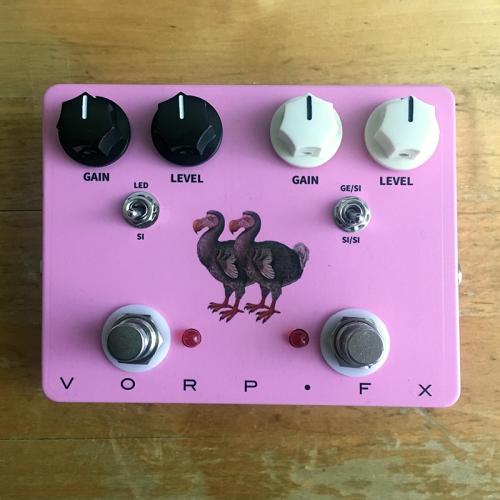Based on one of the most iconic American Overdrive Preamp pedals from the late 1970s, the Double Dodo offers twice the distortion goodness by combining two such pedals in one enclosure. The two distortion stages can be used separately with different settings, or stacked, or one can be used to boost the other. Although referred to as an "overdrive", these are actually hard clipping distortion circuits built around LM741 opamps, but with an extremely wide range of distortion intensity. The Double Dodo extends the sound range of the pedal that inspired it by offering symmetrical silicon diode clipping, asymmetrical silicon/germanium diode clipping, and opamp clipping. As a result, it can be used as a clean boost, for subtle to heavy crunch, full-on distortion, and, with both circuits engaged, even as a fuzz. A tone switch allows two voicings for the distortion.
PEDALS MADE: 36
CURRENT STATUS: TEMPORARILY OUT OF STOCK
FUTURE AVAILABILITY: YES
The starting point for the Double Dodo was the Vintage Dodo, which had been such a pleasant surprise soundwise that it seemed only logical to develop it further. As I have this obsession with adding clipping options to distortion pedals, and some people on the Internet seem to have something of an obsession for for two-DOD250-in-a-box pedals, building just that seemed like the logical step. Different names and designs were considered, but eventually abandoned. I also kept the "vintage" design of the Vintage Dodo as the brushed metal box with the dodo drawings looked nicer than the painted box with the silhouettes. Everything fit so nicely into the horizontal 1590BB enclosure that there was even room for a battery clip, making this my first pedal to allow battery operation (some of the later pedals do not support battery operation).
It's one of my favourite designs, so I'll be making more Double Dodos whenever I am bored and feel like it.
Featured on YouTube
Ryan Burke talks about the Double Dodo in his video on DOD 250-style pedals on his YouTube channel 60 Cycle Hum.
Double Dodo Variations
The Prototype
This is the very first Double Dodo, which has had a permanent spot on my pedal board ever since I built it. I used bi-colour LEDs to indicate the clipping status (red=symmetrical, blue=asymmetrical), but the wiring process was a bit tedious, so I dropped that feature on later pedals. The knob settings that you see here are my preferred ones: the right half is set to a tough crunch, whereas the left half acts as a boster, but uses the asymmetrical clipping option to add a tiny bit of creaminess.
The first series (June - November 2019)
The first series of the Double Dodo came with just one toggle switch per circuit that allowed a choice between symmetrical silicon diode or asymmetrical silicon/germanium diode clipping. The design aimed at replicating a vintage gray box DOD 250. Including the prototype, the first series consisted of eight pedals (serial numbers 1 through 5, 9, 11 and 13).
The 4-Switch Editions
 After some more research on the DOD 250, I found out that there were a number of variants and that my original Double Dodo, even though it sounded great, may not have been one of the actual "classic" gray box versions. I didn't want to sacrifice sound for authenticity, so I decided to add another toggle switch that offers a choice between the regular Double Dodo sound and an exact replica of the 1979 circuit, which sounds somewhat more aggressive and can send the opamp into self-oscillation at high gain settings. Double Dodo serial number 6 was the first pedal with such a switch, here named "Bright". This later became the "1979" Edition, and the "Bright" switch became a "1979/Modern", "1979/Standard" or "1979/Dodo" switch (all these switches do the same thing, I just struggled with the naming). Serial numbers 6 and 12 had 2-position clipping switches (symm/asym), but starting with serial number 15, the pedals had 3-position clipping switches (symm/opamp/asym). In December 2019, I decided that the "1979" edition with the two switches per side would become the new standard model.
After some more research on the DOD 250, I found out that there were a number of variants and that my original Double Dodo, even though it sounded great, may not have been one of the actual "classic" gray box versions. I didn't want to sacrifice sound for authenticity, so I decided to add another toggle switch that offers a choice between the regular Double Dodo sound and an exact replica of the 1979 circuit, which sounds somewhat more aggressive and can send the opamp into self-oscillation at high gain settings. Double Dodo serial number 6 was the first pedal with such a switch, here named "Bright". This later became the "1979" Edition, and the "Bright" switch became a "1979/Modern", "1979/Standard" or "1979/Dodo" switch (all these switches do the same thing, I just struggled with the naming). Serial numbers 6 and 12 had 2-position clipping switches (symm/asym), but starting with serial number 15, the pedals had 3-position clipping switches (symm/opamp/asym). In December 2019, I decided that the "1979" edition with the two switches per side would become the new standard model.
I also made a couple of pedals that replicated the fifth version of the DOD 250 from 1980. These are almost identical to the "1979" eidtion, but use the UA741 opamp instead of the LM741, and have one additional resistor. I called it the "1980" Edition. So far, serial numbers 10, 14, 25 and 34 use this circuit. It may become the standard model once my stock of LM741 opamps is depleted, as these are getting harder to obtain.
In November 2020, I decided to make Double Dodo serial number 25 a one-off special "1980" edition to celebrate the 40th anniversary of the fifth DOD 250 version. I sanded and repainted an enclosure that I had inadvertently scratched a while back and put to use some obscure diodes that I had in stock. The result was this copper-coloured pedal that lacks the "1980/Standard" switch, but instead has single switchable diodes. Both switches down enables symmetrical clipping with two silicon diodes; the left switch up activates a Russian germanium diode, the right switch up enables a Hungarian germanium diode. As a result, the pedal offers four different distortion flavours depending on the switch positions (the two germanium diodes have very different specs). The paint job on the pedal went wrong on several levels, so instead of a lush, luxurious anniversary pedal it became a bit of a golden, shabby duckling. Still, the sound of the pedal more than made up for the less-than-perfect looks - it may be the most intense Double Dodo I built.
The Timewarp Edition
 The Double Dodo "Timewarp Edition" is the result of some research into the DOD 250 circuit: it replicates the 1977 and the 1982 version of that pedal in one box, as usual with a few tweaks. Two of these were built (serial numbers 7 and 8). Read more about this pedal...
The Double Dodo "Timewarp Edition" is the result of some research into the DOD 250 circuit: it replicates the 1977 and the 1982 version of that pedal in one box, as usual with a few tweaks. Two of these were built (serial numbers 7 and 8). Read more about this pedal...
Pink Custom Edition
Stefano from Italy asked me if I could do a custom version of the Double Dodo for him that was more geared towards use with a bass guitar, and he also wanted slightly different clipping options. The result was this pink custom edition (serial number 17).
A Family Portrait
 An assortment of different Double Dodo variants, serial numbers 8 to 14. As you can see, I tried out different enclosure colours, but the unpainted metal is still my favourite finish for this pedal. Left to right, top to bottom: Timewarp Edition, regular edition, 1980 Edition, dark grey regular edition, grey 1979 edition, regular edition, white 1980 edition.
An assortment of different Double Dodo variants, serial numbers 8 to 14. As you can see, I tried out different enclosure colours, but the unpainted metal is still my favourite finish for this pedal. Left to right, top to bottom: Timewarp Edition, regular edition, 1980 Edition, dark grey regular edition, grey 1979 edition, regular edition, white 1980 edition.
Tags: distortion, DOD250, LM741, Si diodes





